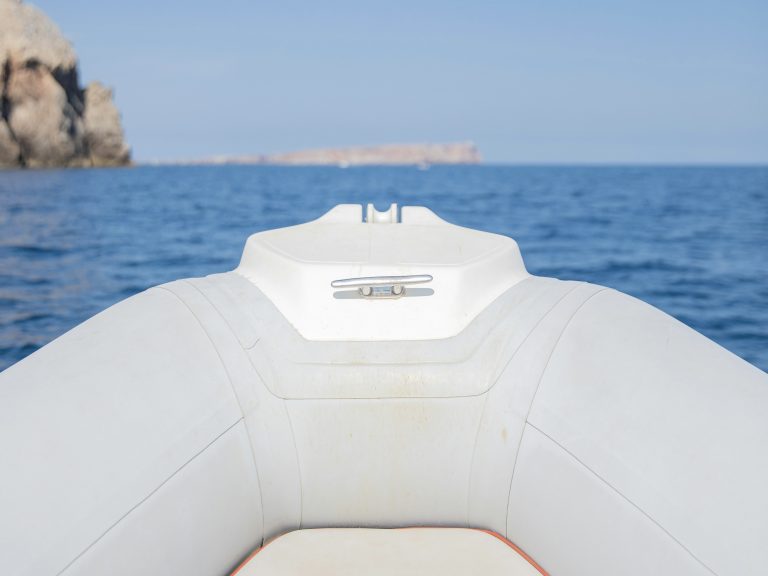If you’re interested in the world of Rigid Inflatable Boats (RIBs), you’ve likely encountered the terms Hypalon and PVC. These two materials are often at the center of debates, with many conflicting opinions circulating. So, what’s the real difference between Hypalon vs PVC? What are the advantages of each material? And how can you tell which one your boat is made from? In this article, we’ll break down the pros and cons of both materials and provide an objective comparison to help clear up the confusion.
1) Definitions of Hypalon and PVC
While it may seem straightforward, it’s essential to first understand what these materials are, as this will lay the foundation for the rest of the article and help clarify the key points.
Hypalon: Chlorosulfonated Polyethylene, or CSM (marketed as Hypalon), is a specialized form of chlorosulfonated rubber developed by DuPont in the 1950s. Originally designed for military use, it was employed in products such as life jackets and chemical-resistant suits. Today, Hypalon is most commonly used in the construction of Rigid Inflatable Boat (RIB) tubes, though its versatility has led to applications in various industries. From personal protective equipment to gangways in mass transit systems (buses, trams, and high-speed trains), Hypalon continues to be valued for its resilience and adaptability in demanding environments.
PVC: Polyvinyl Chloride (PVC) is a widely used synthetic plastic polymer, first polymerized in 1920, and the most popular thermoplastic in the world. Initially, PVC was used in the construction of pipes and electrical insulation due to its durability, low cost, and ease of production. Over time, its applications have expanded to a wide range of industries due to its versatility, chemical resistance, and moldability. Today, PVC is used in everything from plumbing pipes and window frames to flooring, medical devices, and electrical cables. It can be produced in both rigid and flexible forms, with the flexible variation commonly used in medical equipment, automotive components, and clothing. It is also commonly used in the construction of Rigid Inflatable Boats.
2) Differences between Hypalon and PVC
While many articles highlight the differences between Hypalon and PVC, they often lack context or market perspective. In this brief overview, we’ll explain everything you need to know about these two materials and how they fit into the market.
Processing differences: Gluing vs. welding
The main difference lies in how the materials are processed: Hypalon is glued, while PVC is welded (using hot air or high frequency). Hypalon’s process requires more craftsmanship, while PVC is better suited for mass production. As a result, creating a tube from Hypalon is more labor-intensive and time-consuming. The process involves buffing the fabric, applying the glue, and allowing sufficient drying time.
Material performance: Hypalon’s edge in harsh conditions
Hypalon remains the most durable and reliable material in extreme conditions. It offers superior resistance to cold, high temperatures, UV rays, and better color stability. This makes it especially well-suited for regions with intense sun exposure, such as Florida, Australia, and Southeast Asia. However, in countries with milder climates, the latest generations of PVC perform well and last over time. PVC isn’t inherently a poor option; it’s a relevant alternative when the conditions are suitable.
Market trends: Hypalon for premium RIBs, PVC for smaller boats
Given Hypalon’s performance in extreme conditions, it dominates the market for larger, premium RIBs. While it is more expensive, the additional cost is often absorbed into the overall price of the boat. In contrast, boats under 6 meters are more commonly made with PVC, as price sensitivity is greater in this segment. With rising raw material costs, manufacturers opt for PVC to offer more competitively priced options.
How to tell Hypalon from PVC?
Think of Hypalon as rubber and PVC as plastic. Press your finger against both materials and you’ll notice the difference: Hypalon feels softer and more pliable, while PVC feels firmer and less forgiving. You may also notice visible traces of glue or adhesive around the seams for Hypalon, while PVC often shows bulges where the material is fused together.
3) The main manufacturers of Hypalon and PVC
As the world of Rigid Inflatable Boats (RIBs) has grown steadily in recent years, it has relied on well-established suppliers. Among them, suppliers of coated fabrics have played a key role in meeting the growing demand from manufacturers.
Hypalon: Pennel & Flipo (ORCA®) is undoubtedly the most important and well-known manufacturer of Hypalon fabric. Based in Mouscron, Belgium, the company, now part of the Michelin Group, celebrated its 100th anniversary in November 2024. Focusing on innovation, quality, and excellence, Pennel & Flipo has become a trusted partner for many RIB brands, supporting leisure, professional, and defense boat manufacturers. It has developed the most comprehensive range of fabrics on the market, combining different colors, finishes, and mechanical properties to suit the diverse needs of boat builders. You can discover more at www.orca.eu and on their recently launched webstore, www.orcaretail.com.
Although less well-known, other fabric suppliers have established a presence in the market, such as Achilles (Japan), Novurania (Italy), and Formosan Rubber Group (Taiwan).
PVC: Mehler Texnologies® is a leading German company renowned for producing technical coated textiles for a wide range of applications. With factories in Germany and the Czech Republic, Mehler specializes in PVC fabrics tailored for the construction of Rigid Inflatable Boats (RIBs) through its Valmex® portfolio, which includes a variety of colors and thicknesses. If you buy a PVC boat, there’s a good chance its fabric comes from this company. Explore more at www.mehler-texnologies.com.
Conclusion
In conclusion, both Hypalon and PVC offer distinct benefits. Rather than competing, these materials complement each other, catering to different needs based on performance and the cost considerations that buyers prioritize. Hypalon is the go-to choice for premium boats, while PVC offers a budget-friendly alternative. Consider your budget, area of navigation, and frequency of use to see which one is the best fit for you. No matter your choice, both materials can help ensure your boat delivers an unforgettable adventure on the water!
